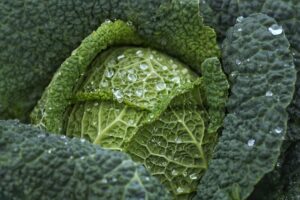Introduction
The best Zone 7 Cabbage Cultivars include Early Jersey, Copenhagen Market and Golden Acre. Learn how to grow cabbage in Zone 7!

Zone 7 Overview
Zone 7 encompasses a significant portion of the United States, stretching from coastal Virginia to Texas. This zone is characterized by its moderate climate, with average winter lows hovering between 0 to 10 degrees Fahrenheit and summer highs often reaching into the 80s or 90s. It enjoys a relatively long growing season, typically extending from early spring through late fall, making it suitable for a broad variety of plants, including several Zone 7 cabbage cultivars to try.
Importance of Choosing the Right Cabbage Cultivars for Zone 7
Choosing the right Zone 7 cabbage cultivars is critical to successful cabbage farming. The compatibility of the cultivar with the local climate and soil conditions can significantly influence the yield and quality of the crop. Zone 7’s moderate temperatures are conducive to several cabbage cultivars, but it’s essential to choose those that can thrive under its specific summer heat and winter chill conditions. The correct cultivar can resist local pests and diseases, require less maintenance, and produce a bountiful, healthy crop. Thus, cultivar selection is a strategic decision with economic implications for farmers and gardeners in this zone.
Best Cabbage Cultivars for Zone 7
Early Jersey Wakefield
Early Jersey Wakefield is one of the choice cabbage cultivars suitable for Zone 7 due to its adaptability and resilience. Characterized by its distinct, elongated heads that taper to a point, this variety is known for its early maturation and exceptional flavor. The heads typically weigh 2 to 3 lbs and turn a lovely shade of green when mature. Notably, Early Jersey Wakefield boasts a sweet and tender taste, a trait that makes it a favorite among both home gardeners and commercial farmers. The plant is compact and can be grown in tighter spaces than many other cultivars, making it a versatile choice for different garden layouts. It’s a cool-season crop, ideal for both spring and fall planting in Zone 7, and usually ready to harvest in 60-75 days. Its resilience to pests and diseases, combined with its ability to withstand the moderate temperatures of Zone 7, make it a reliable and rewarding choice for cabbage cultivation.
Golden Acre
Golden Acre is another highly recommended cabbage cultivar for growers in Zone 7. This variety is prized for its fast growth rate and compact size, often producing heads that weigh around 3-5 lbs and are ready to harvest within 65 days. The heads of the Golden Acre cabbage are round and dense, and as the name suggests, they develop a beautiful golden hue when mature. Known for its sweet and mild flavor, Golden Acre is a perfect choice for fresh consumption or for use in coleslaw and sauerkraut. This variety is adaptable to a range of soil conditions, showing appreciable tolerance to different pH levels, and can thrive well in both the milder summers and colder winters of Zone 7. Additionally, the Golden Acre cabbage is known for its resistance to yellows disease, giving it an added advantage in terms of resilience and yield stability. Its compact growth habit allows for closer planting, making it a suitable option for gardeners with space constraints.
Copenhagen Market
Copenhagen Market is yet another cabbage variety that thrives in Zone 7. Renowned for its early maturity, this cultivar typically yields ready-to-harvest heads within 70 days, a factor which makes it popular among gardeners aiming for a quick harvest. The heads are round and solid, typically weighing between 3-4 lbs and boasting a light green color when fully mature. They are known for their crisp texture and a delightful, sweet taste, making them a favored choice for salads and coleslaw. The Copenhagen Market variety exhibits a high tolerance for a range of soil conditions, including varying pH levels, and is resilient against common cabbage diseases. This type of cabbage is also celebrated for its excellent storage qualities, retaining its taste and texture for extended periods post-harvest. Its compact growth allows for high-density planting, making it an excellent choice for those with limited garden space.
How to Grow Cabbage in Zone 7
Proper soil preparation is a critical step for growing a thriving cabbage crop in Zone 7. The soil pH and nutrient balance play a particularly significant role in the growth and health of cabbage plants. Cabbages prefer a slightly acidic to neutral pH, generally in the range of 6.0-7.0. Maintaining the right pH level ensures optimal nutrient absorption and enhances the plants’ resistance against diseases. On the other hand, the importance of nutrient balance cannot be overstated. Cabbages require a rich, well-fertilized soil, with a good balance of Nitrogen, Phosphorus, and Potassium for healthy growth. Nitrogen promotes leafy growth, Potassium ensures robust root development and disease resistance, while Phosphorus aids in energy transfer and photosynthesis. Therefore, before planting, it’s important to test the soil and, if needed, amend it with organic matter or fertilizers to achieve the desired pH and nutrient balance.
Planting Cabbage: Timing, Spacing, and Depth
The timing of planting is crucial for achieving a successful cabbage harvest. In Zone 7, it is recommended to start cabbage seeds indoors 6-8 weeks before the last spring frost or plant them directly outdoors 2-4 weeks before the last expected frost date. For a fall harvest, start seeds indoors or directly sow into the garden about 12-14 weeks before the first frost of fall.
When it comes to spacing, the recommended distance between each plant is roughly 12-24 inches apart in rows that are 24-36 inches apart. This spacing allows for ample airflow and sunlight, yet gives each plant enough room to mature without competition.
As for the planting depth, cabbage seeds should be sown approximately 1/4 to 1/2 inch deep in the soil. This shallow depth allows the seeds to germinate and emerge quickly, while also preventing them from getting buried too deeply which could hinder their development. Remember to water the newly planted seeds well and keep the soil consistently moist during the germination period.
Maintenance: Watering, Feeding, and Pest Control
Cabbage plants require consistent watering, generally an inch of water per week, either from rain or irrigation. Keeping the soil moist, not waterlogged, is crucial for the healthy growth of cabbages. Drought stress can cause small, strong-flavored heads and may even lead to splitting. Mulching around the plants helps conserve moisture and prevent weeds competition.
In terms of feeding, a side dressing of nitrogen fertilizer about halfway through the growing season is beneficial. This additional feeding supports the plants in developing large, tasty heads. Use a balanced vegetable garden fertilizer (10-10-10) or a slow-release granular type to give your cabbage the nutrients it needs.
Pest control is a vital part of maintaining a healthy cabbage crop. Common pests like cabbage worms, aphids, and cutworms can be a menace. Using floating row covers helps deter these pests. For severe infestations, consider using organic or chemical pesticides, but always follow label instructions strictly. Companion planting with aromatic herbs or flowers can also be an effective, natural pest deterrent. Regularly check your plants for signs of pests or diseases and take action promptly to prevent potential crop loss.
Harvesting Cabbage: When and How to Maximize Yield and Taste
Cabbage is typically ready to harvest in 70 to 100 days from planting. The exact time can depend on the variety and growing conditions. The key indicator that your cabbages are ready to harvest is the firmness of the head. Press gently on the head; if it feels dense and solid, it’s likely ready to harvest.
To harvest, use a sharp knife to cut the head off at the base. Be careful not to damage the surrounding leaves, as they protect the head and enhance its storage life. If conditions are right and the plant is healthy, you might get a second, smaller crop from the remaining plant.
Harvesting in the cool of the early morning can help to enhance the flavor of the cabbage. Once harvested, remove any loose or damaged outer leaves and store the cabbage in a cool, moist place. It’s also worth noting that cabbages can be left in the garden until you’re ready to use them, as long as pests, disease, or freezing temperatures don’t threaten.
By following these harvesting guidelines, you can maximize the yield and taste of your homegrown cabbage.
Conclusion
In conclusion, for those residing in Zone 7, the optimal cabbage cultivars include the robust ‘Late Flat Dutch’, the quick-to-harvest ‘Golden Acre’, and the wonderfully crinkled ‘Savoy Perfection’. Each of these cultivars brings their unique qualities and characteristics, making them superb choices for different gardeners’ preferences.
- The ‘Late Flat Dutch’ is highly valued for its large, dense heads and excellent keeping qualities. It requires a longer growing period, typically ready to harvest in 100 days, offering large yields perfect for preservation or winter storage.
- The ‘Golden Acre’ stands out for its short maturity time, with harvest-ready heads in just 65 days. Its smaller size makes it a great choice for gardeners with limited space or those wanting a quick yield.
- ‘Savoy Perfection’, distinguished by its attractive ruffled leaves, offers a unique texture and flavor to any dish. It’s typically ready to harvest in 85-95 days.
Irrespective of the chosen cultivar, consistent adherence to the discussed cultivation guidelines, from soil preparation and planting to pest control and harvesting, is crucial to reap a healthy, flavorful cabbage crop. By paying careful attention to these factors, gardeners in Zone 7 can enjoy the satisfaction and benefits of homegrown cabbage.

